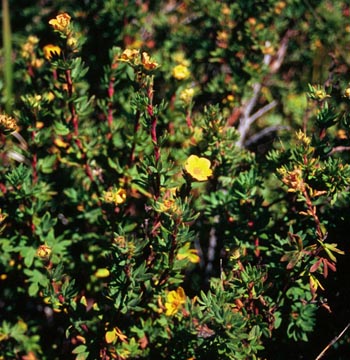Shrubby Cinquefoil

Common Name(s):
Shrubby Cinquefoil
Scientific Name:
Dasiphora fruiticosa auct. non (L.) Rydb.
Scientific Name Synonyms:
Dasiphora floribunda (Pursh) Kartesz, comb. Nov. ined.
Potentilla fruticosa Pursh
Symbol:
DAFRF
Description:
Life Span: Perennial
Origin: Native
Season: Cool
Growth Characteristics: Shrubby cinquefoil is a deciduous, multi-stemmed and many branched shrub, reaching heights of 1 to 6.5 feet. The growth form of shrubby cinquefoil varies; it occurs as a low mat and as an erect shrub. Shrubby cinquefoil has a shallow to moderately deep, spreading root system with thin woody roots. Flowers from late May to late September, seeds mature from late summer to early fall. Regenerates from wind-dispersed seed and by sprouting from the root crown.
Flowers/Inflorescence: Shrubby cinquefoil flowers are terminal, occasionally with solitary flowers but usually with many flowers in close clusters. The flowers are yellow and rose-like, with 5 petals.
Fruits/Seeds: Generally, shrubby cinquefoil produces approximately 50 seeds, in the form of hairy achenes, per flower.
Leaves: Shrubby cinquefoil has numerous alternate leaves with 3 to 9 leaflets that have long white hairs on both surfaces. The lower surface of the leaves has many stomata; the upper surface has none.
Stems: Shrubby cinquefoil branches are pubescent in the first year, becoming brown and glabrous in the second year. Bark becomes fibrous on branches in the second and third years. Mature plants have both erect and prostrate branches, the latter able to root adventitiously.
Ecological Adaptions:
Shrubby cinquefoil occupies a wide variety of sites and is distributed from low valleys to mountain peaks, growing in riparian communities, around springs, wetland sites, upland sites, rock ledges, and subalpine and alpine sites, at elevations from 6,000 to 10,000 feet. Shrubby cinquefoil often occurs as transitional vegetation from wetland sites to drier upland sites and from foothills to mountains in the western part of its range.
Shrubby cinquefoil has fair to weakly moderate drought tolerance. It prefers open sites, but will grow under light shade. It is cold tolerant and winter hardy.
Soils: Shrubby cinquefoil is found on a wide range of soil classes, from clay, fine loam, sandy loam, and loamy skeletal soils to coarse textured soils. Grows well on most textural classes, except dense clay and loose sand. Soils may be poor to well-drained. Shrubby cinquefoil is tolerant of wet conditions and flooding, and calcareous substrates. It is also tolerant of weakly saline and moderately acid to moderately basic soils; it is often found on calcareous sites.
Associated Species: Quaking aspen, willows, birch, sedges, wild rose.
Uses and Management:
Though it has low forage value, shrubby cinquefoil's widespread distribution, persistent leaves, and low spreading growth form make it an important source of forage for ungulates. It is not preferred forage in Utah, but is lightly browsed by mule deer, elk, mountain goats, and bighorn sheep throughout its range. Winter use of shrubby cinquefoil by deer and elk is also typically light. It is a low preference shrub for bighorn sheep, though it receives moderate to heavy use when new growth begins. Small birds and mammals consume shrubby cinquefoil seeds.
Shrubby cinquefoil is tolerant to moderate defoliation by grazing but is injured by repeated defoliation, especially when accompanied by drought conditions, and may be killed by browsing or trampling.
Shrubby cinquefoil is useful for erosion control and soil stabilization, and may be useful in wildlife habitat mitigation.
The leaves, roots, and stems of shrubby cinquefoil were commonly used by Native Americans to make teas to treat internal bleeding, congestion, and tuberculosis. Dried leaves were also made into a mixture considered an arrow poison that was thought to go directly to the heart. Dried, finely powdered leaves were believed to protect the body from severe, temporary heat.

